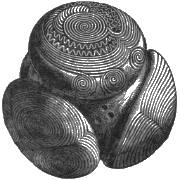Canmore Site 40852: SHANTER KNOWE - KIRKOSWALD - MOTTE (MEDIEVAL)(POSSIBLE)
Description
| Site Name | SHANTER KNOWE |
|---|---|
| Other Name(s) | n/a |
| Site Number | NS20NW 3 |
| Broad Class | MONUMENT (BY FORM), DEFENCE |
| Site Type(s) | MOTTE (MEDIEVAL)(POSSIBLE) |
| NGR | NS 2189 0738 |
| NGR accuracy | NGR given to the nearest 10m |
| Local Authority | SOUTH AYRSHIRE |
| Parish | KIRKOSWALD |
| Record created | 1988-03-07 |
| Last updated | 2000-04-12 |
Archaeology Notes
NS20NW 3 2189 0738.
NS20NW 3 2189 0738 Shanter Knowe (NAT) Motte (NR)
OS 1:10000 map (1972)
Shanter Knowe, a motte (information from RCAHMS, visited 1953) is placed on sloping ground, its height varying from 12ft to 20ft; its flat top is 33ft in diameter and the base is roughly 80ft in diameter. It was excavated in 1894 by the Marquis of Ailsa. Dark, loamy soil was found about 6ft down, and it was only in this layer that relics were found: they comprised animal bones, teeth, a flint scraper, flint cores and flakes, a bronze pin, a lead whorl, part of an iron chain, some wheel-turned, partly glazed pottery, also shells. The RCAHMS consider that the finds doubtless represent and earlier occupation of the site. After the excavation, the soil was replaced and the mound restored to its former state.
Ailsa 1894; J Smith 1895
A flint fabricator from here is in the National Museum of Antiquities of Scotland (NMAS) (Acc No: AA 105).
NMAS MS Accessions List
This motte is generally as described. Composed of sand and pebbles, it is some 6.0m in height while its flat summit is 9.0m by 8.0m. It is grass-covered.
Resurveyd at 1:2500.
Visited by OS (RD) 14 March 1967
This mound, which is generally as described, is not a motte. It is apparently entirely composed of sandy loam and no stone is evident. There is no evidence of its ever having been enclosed by a ditch. It occupies a high point in a cultivated area. Its origin is not clear and the excavation gives no positive clue to its date or purpose.
Visited by OS (MJF) 29 October 1980
This mound, situated 500m ENE of Shanter farmhouse, may be a motte; it stands to a height of at least 3.5m and its level top is about 9m in diameter. When the mound was excavated in the late 19th century the finds (none of which occurred less than 1.5m below the surface of the mound) included sherds of medieval pottery, flints, animal bone, a 'bronze or brass' pin, a lead whorl, part of an iron chain, two iron nails and several pieces of slag ('apparently of iron').
RCAHMS 1983, visited 1982
Identifiers and Links to Other Records
This record has no links! Would you like to help?
| Identifier / External Link | Linked Record | Status | Comment |
|---|---|---|---|
| Canmore Site Number (legacy): NS20NW 3 | No linked record |
This area is visible only to logged in users.
